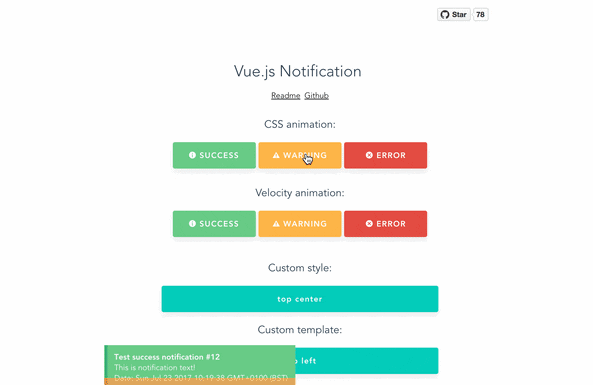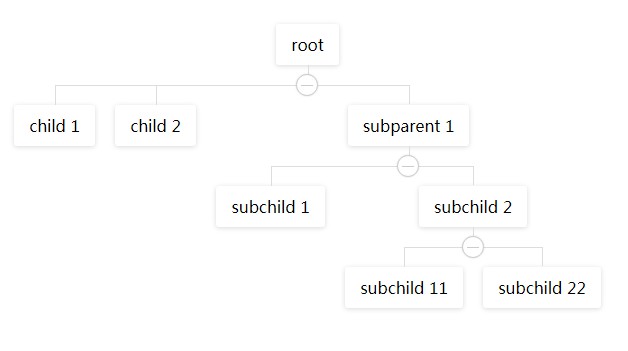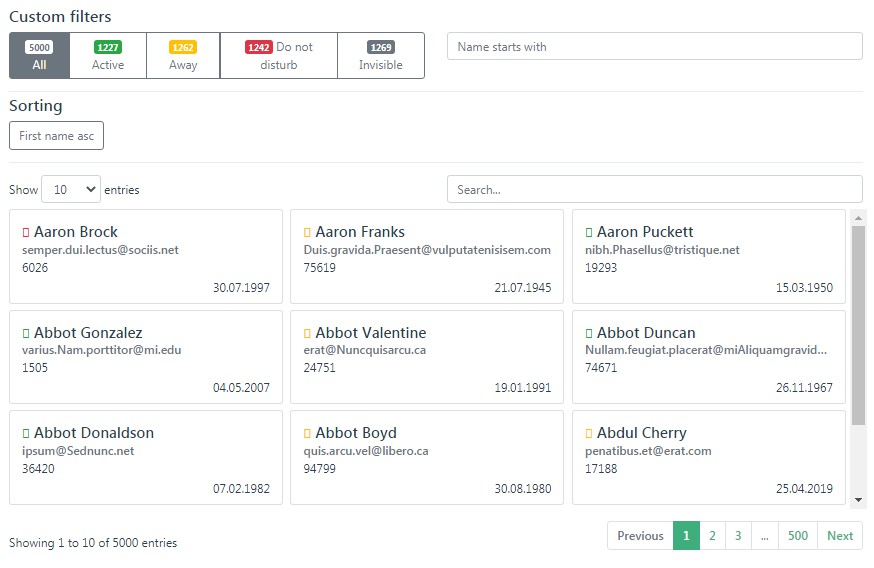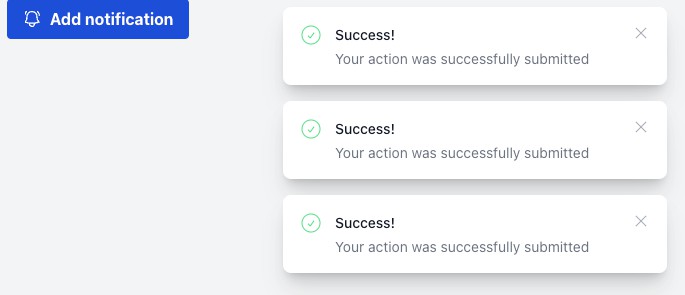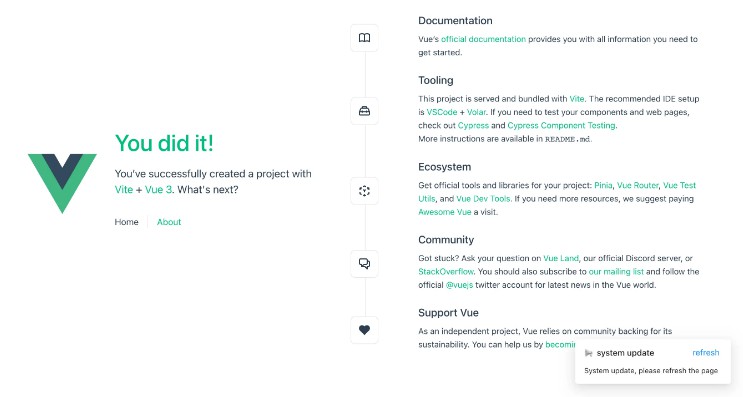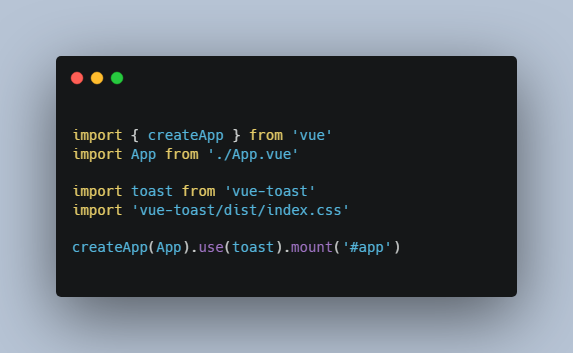Vue.js notifications
A simple notification library for vue3.
This is a fork and port of Vue 2 vue-notifications created by euvl to now support Vue 3. If you're using Vue 2.x use his version.
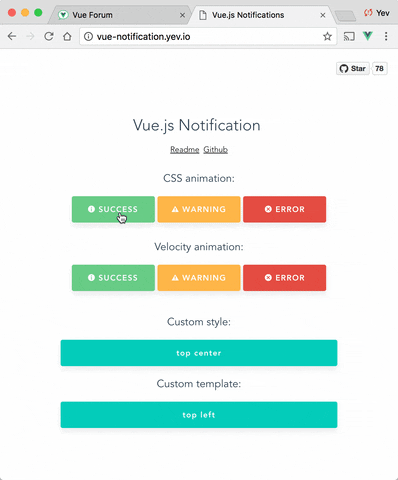
Setup
npm install --save @kyvg/vue3-notification
yarn add @kyvg/vue3-notification
Add dependencies to your main.js:
import { createApp } from 'vue'
import Notifications from '@kyvg/vue3-notification'
const app = createApp({...})
app.use(Notifications)
Add the global component to your App.vue:
<notifications />
Usage
Trigger notifications from your .vue files:
// simple
this.$notify("Hello user!");
// using options
this.$notify({
title: "Important message",
text: "Hello user!",
});
Or trigger notifications from other files, for example, your router:
import { notify } from "@kyvg/vue3-notification";
notify({
title: "Authorization",
text: "You have been logged in!",
});
Migration
Vue 2.x syntax
Vue.notify({
title: "Vue 2 notification",
});
Vue 3.x syntax
import { notify } from "@kyvg/vue3-notification";
notify({
title: "Vue 3 notification ?",
});
Component props
The majority of settings for the Notifications component are configured using props:
<notifications position="bottom right" classes="my-custom-class" />
Note that all props are optional.
| Name | Type | Default | Description |
|---|---|---|---|
| position | String/Array | 'top right' | Part of the screen where notifications will pop out |
| width | Number/String | 300 | Width of notification holder, can be %, px string or number.Valid values: '100%', '200px', 200 |
| classes | String/Array | 'vue-notification' | List of classes that will be applied to notification element |
| group | String | null | Name of the notification holder, if specified |
| duration | Number | 3000 | Time (in ms) to keep the notification on screen (if negative - notification will stay forever or until clicked) |
| speed | Number | 300 | Time (in ms) to show / hide notifications |
| animation-type | String | 'css' | Type of animation, currently supported types are css and velocity |
| animation-name | String | null | Animation name required for css animation |
| animation | Object | Custom | Animation configuration for Velocity animation |
| max | Number | Infinity | Maximum number of notifications that can be shown in notification holder |
| reverse | Boolean | false | Show notifications in reverse order |
| ignoreDuplicates | Boolean | false | Ignore repeated instances of the same notification |
| closeOnClick | Boolean | true | Close notification when clicked |
API
Notifications are triggered via the API:
this.$notify({
// (optional)
// Name of the notification holder
group: 'foo',
// (optional)
// Title (will be wrapped in div.notification-title)
title: 'This is the <em>title</em>',
// Content (will be wrapped in div.notification-content)
text: 'This is some <b>content</b>',
// (optional)
// Class that will be assigned to the notification
type: 'warn',
// (optional, override)
// Time (in ms) to keep the notification on screen
duration: 10000,
// (optional, override)
// Time (in ms) to show / hide notifications
speed: 1000
// (optional)
// Data object that can be used in your template
data: {}
})
To remove notifications, include the clean: true parameter.
this.$notify({
group: "foo", // clean only the foo group
clean: true,
});
Plugin Options
Configure the plugin itself using an additional options object:
app.use(Notifications({ name: "alert" }));
All options are optional:
| Name | Type | Default | Description |
|---|---|---|---|
| name | String | notify | Defines the instance name. It's prefixed with the dollar sign. E.g. $notify |
| componentName | String | notifications | The component's name |
Note: setting
componentNamecan cause issues when using SSR.
Features
Position
Position the component on the screen using the position prop:
<notifications position="bottom right" />
It requires a string with two keywords for vertical and horizontal postion.
Format: "<vertical> <horizontal>".
- Horizontal options:
left,center,right - Vertical options:
top,bottom
Default is "top right".
Width
Width can be set using a number or string with optional % or px extensions:
<notifications :width="100" />
<notifications width="100" />
<notifications width="100%" />
<notifications width="100px" />
Type
Set the type of a notification (warn, error, success, etc) by adding a type property to the call:
this.$notify({ type: "success", text: "The operation completed" });
This will add the type (i.e. "success") as a CSS class name to the .vue-notification element.
See the Styling section for how to hook onto the class and style the popup.
Groups
For different classes of notifications, i.e...
- authentication errors (top center)
- app notifications (bottom-right)
...specify the group attribute:
<notifications group="auth" position="top" />
<notifications group="app" position="bottom right" />
Trigger a notification for a specific group by specifying it in the API call:
this.$notify({ group: "auth", text: "Wrong password, please try again" });
Customisation
Styling
Vue Notifications comes with default styling, but it's easy to replace with your own.
Specify one or more class hooks via the classes prop on the global component:
<notifications classes="my-notification" />
This will add the supplied class/classes to individual notification elements:
<div class="vue-notification-wrapper">
<div class="vue-notification-template my-notification">
<div class="notification-title">Info</div>
<div class="notification-content">You have been logged in</div>
</div>
</div>
Then include custom css rules to style the notifications:
// style of the notification itself
.my-notification {
/*...*/
// style for title line
.notification-title {
/*...*/
}
// style for content
.notification-content {
/*...*/
}
// additional styling hook when using`type` parameter, i.e. this.$notify({ type: 'success', message: 'Yay!' })
&.success {
/*...*/
}
&.info {
/*...*/
}
&.error {
/*...*/
}
}
Note that the default rules are:
.vue-notification {
// styling
margin: 0 5px 5px;
padding: 10px;
font-size: 12px;
color: #ffffff;
// default (blue)
background: #44a4fc;
border-left: 5px solid #187fe7;
// types (green, amber, red)
&.success {
background: #68cd86;
border-left-color: #42a85f;
}
&.warn {
background: #ffb648;
border-left-color: #f48a06;
}
&.error {
background: #e54d42;
border-left-color: #b82e24;
}
}
Content
To completely replace notification content, use Vue's slots system:
<notifications>
<template slot="body" slot-scope="{ item, close }">
<div class="my-notification">
<p class="title">
{{ item.title }}
</p>
<button class="close" @click="close">
<i class="fa fa-fw fa-close"></i>
</button>
<div v-html="props.item.text"/>
</div>
</template>
</notifications>
The props object has the following members:
| Name | Type | Description |
|---|---|---|
| item | Object | Notification object |
| close | Function | A function to close the notification |
Animation
Vue Notification can use the Velocity library to power the animations using JavaScript.
To use, manually install velocity-animate & pass the library to the vue-notification plugin (the reason for doing that is to reduce the size of this plugin).
In your main.js:
import { createApp } from 'vue'
import Notifications from '@kyvg/vue3-notification'
import velocity from 'velocity-animate'
const app = createApp({...})
app.use(Notifications, { velocity ))
In the template, set the animation-type prop:
<notifications animation-type="velocity" />
The default configuration is:
{
enter: { opacity: [1, 0] },
leave: { opacity: [0, 1] }
}
To assign a custom animation, use the animation prop:
<notifications animation-type="velocity" :animation="animation" />
Note that enter and leave can be an object or a function that returns an object:
computed: {
animation () {
return {
/**
* Animation function
*
* Runs before animating, so you can take the initial height, width, color, etc
* @param {HTMLElement} element The notification element
*/
enter (element) {
let height = element.clientHeight
return {
// animates from 0px to "height"
height: [height, 0],
// animates from 0 to random opacity (in range between 0.5 and 1)
opacity: [Math.random() * 0.5 + 0.5, 0]
}
},
leave: {
height: 0,
opacity: 0
}
}
}
}
FAQ
Check closed issues with FAQ label to get answers for most asked questions.
Development
To run a local demo:
# run the demo
cd demo
npm install
npm run dev
To contribute to the library:
# build main library
npm install
npm run build
# run tests
npm run test
# watch unit tests
npm run unit:watch
